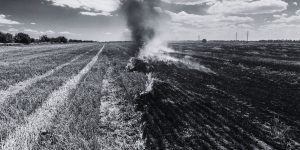What Happened On May 18th?
On May 18, 1927, the deadliest school massacre in U.S. history rattled the quiet farming community of Bath Township, Michigan.
At approximately 8:45 a.m., an explosion ripped through the north wing of the school, collapsing the roof and trapping students and teachers under the rubble. Through the panic, rescuers worked frantically to free the survivors.
As the community reeled from the initial explosion, the culprit in full business attire, drove his truck to the scene. Around 9:45 a.m., he detonated the truck, killing himself and several others, including the school superintendent, Emory Huyck.
Who Did This?
It was Andrew Kehoe, a 55-year-old school board treasurer, who was the mastermind behind the massacre. Kehoe, who had a reputation for being meticulous and controlling, was deeply resentful over the increased taxes levied to fund the construction of the Bath Consolidated School.
His financial troubles were exacerbated by his failing farm and the illness of his wife, Nellie. Consumed by anger and despair, Kehoe meticulously planned the attack as a final act of revenge against the community he blamed for his misfortunes.
His Actions
Early in the morning of May 18th, he began by killing his wife and setting fire to his farm buildings, ensuring the fire would draw attention and delay responses to the school.

Before driving to the school to carry out his final act of destruction, Kehoe attached a sign to the fence at his farm. The sign, which read “Criminals are made, not born,” offered a chilling glimpse into Kehoe’s mindset and his belief that he had been driven to his actions by external forces.
As firefighters and neighbors rushed to his property, Kehoe drove to the Bath Consolidated School, where he had secretly planted dynamite and pyrotol over the course of several months.
In the aftermath of the tragedy, authorities discovered an additional 500 pounds of unexploded dynamite in the south wing of the school. Had these explosives detonated, the death toll could have been even higher. The presence of these undetonated explosives underscored the extent of Kehoe’s planning and the potential for even greater devastation.
The Victims
The Bath School Disaster claimed the lives of 45 individuals, including 38 children between the ages of 7 and 14. The young victims were all students at the Bath Consolidated School, a symbol of the community’s aspirations for better education and a brighter future. The loss of these innocent lives was a profound blow to the community, which struggled to comprehend the magnitude of Kehoe’s actions.
Glenn Smith, the school point master, rescued many of the trapped children. Despite the danger, Smith repeatedly entered the building to pull students from the wreckage. Smith’s bravery saved numerous lives, but when Kehoe arrived at 9:45 a.m., his leg was severed due to the secondary bombing. Thus, he lost an excessive amount of blood and tragically passed.
The Communal Response
In the wake of the disaster, the community of Bath Township rallied together to support the survivors and rebuild the school. Donations poured in from across the country, and the new James Couzens School was completed in 1928. The tragedy forged a strong sense of solidarity among the residents, who were determined to honor the memory of the victims.

Of course, many of the children who survived the massacre were deeply traumatized by the events of that day. In later years, some survivors spoke of their ongoing struggles with nightmares and anxiety. Despite these challenges, many survivors went on to lead full lives, demonstrating an incredible amount of resilience.
School Shootings Have Increased
Since the Bath School Disaster, the United States has seen a disturbing rise in school shootings. According to data from the International Foundation For Protection Officers, there have been over 1,300 school shootings since 1970.
In recent years, these incidents have become alarmingly common, with notable tragedies such as the Columbine High School massacre in 1999, the Sandy Hook Elementary School shooting in 2012, and the Marjory Stoneman Douglas High School shooting in 2018.
Several factors contribute to the prevalence of school shootings today, including access to firearms, mental health issues, and societal factors such as bullying and social isolation. The ease with which individuals can obtain guns has made it possible for potential perpetrators to carry out attacks with devastating efficiency.
Additionally, mental health issues, often exacerbated by a lack of adequate support systems, attribute to these incidents.
Efforts to address the root causes of school shootings have included calls for stricter gun control measures, improved mental health services, and enhanced security protocols in schools. Despite these efforts, these issues are prominent, and the threat to student safety persists.





